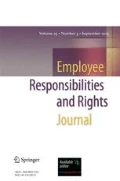Students of labor history are well aware that trade unions experience periods of intense activity as well as times of relative quietude. For example, events such as collective bargaining negotiations and strikes often stimulate high levels of membership participation while the periods between such episodes are often characterized by minimal membership involvement. Additionally, the behavior of trade union officials is often quite different when they are engaged in leading strikes or contract negotiations in comparison to administering collective bargaining agreements in times of comparative normalcy.
In this perceptive, well-written and stimulating “Perspectives” Section article, Jonathan Lepie outlines a theoretical position for explaining such trade union behavior. Having worked as a union organizer, business agent and negotiator for several unions including the International Ladies’ Garment Workers’ Union, the Service Employees International Union (SEIU) Local 535, the Union of American Physicians and Dentists and the American Federation of State, County and Municipal Employees Local 800 for more than three decades, Lepie retired as SEIU Local 535’s organizing director in 2005. Lepie argues that unionism experiences two distinctive states, a low-energy state and a high-energy state, which operate at different times and serve varied purposes during a union’s existence. Moreover, he points out that each state of unionism favors a particular type of union leader who is more effective in directing the union during the labor organization’s low-energy state versus its high-energy state. Drawing on a number of colorful examples, primarily from U.S. and British labor history, Lepie provides empirical support for his theoretical formulation which explains the differences in the behavior of trade union leaders and their respective labor organizations during their high-energy and low-energy states.
If any of the journal’s readers are interested in responding to any essays published in the “Perspectives” Section or would like to write articles on any topics in the field of employee relations, please do not hesitate to contact me with your proposal. I welcome both practitioner-based and scholarly-based articles written from any one of a variety of theoretical perspectives. I hope that you enjoy this article and find it most illuminating.
Author information
Authors and Affiliations
Corresponding author
Rights and permissions
About this article
Cite this article
Devinatz, V.G. Introduction to “The Quantum States of Unionism”. Employ Respons Rights J 27, 161 (2015). https://doi.org/10.1007/s10672-015-9259-4
Published:
Issue Date:
DOI: https://doi.org/10.1007/s10672-015-9259-4

